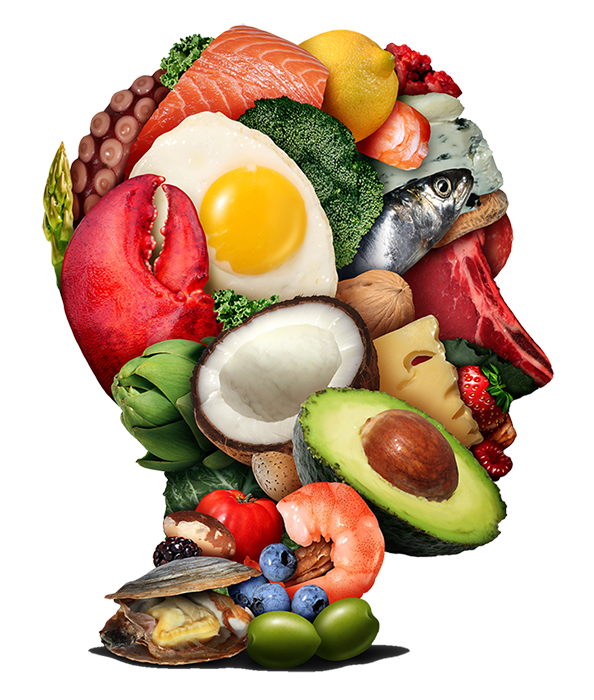It is the process by which an organism obtain its nourishment, the supply of nutrients required by its body and cells to stay alive.
Types: Autotrophic nutrition and Heterotrophic nutrition

Autotrophic Nutrition:
- Plant exhibit autotrophic mode
- They prepare their own food by the process of photosynthesis
- Also called self-nourishment
- These are of two types:
- Photosynthesis
6 CO2 + 6H2O C6H12O6 + 6O2
Radiant energy
Of sunlight and
chlorophyll
Occurs in all green plants
- Chemosynthesis
CO2 +H20 CARBOHYDRATES
Chemical nutrients
Sunlight is not used as an energy source
Used for energy in photosynthesis.
Heterotrophic Nutrition:
- Animals exhibit heterotrophic mode
- These are directly or indirectly dependent upon the autotrophs for their organic food
- They have no chlorophyll so these cannot trap the radiant energy of sunlight
- Types:
- Holozoic or helotrophic
Organism takes in whole food, i.e., whole plant or whole animal or their parts. The food ingested undergoes digestion, absorption and assimilation.
e.g.: small organisms like Amoeba and large organism like Human beings.
Depending upon source of food, they are differentiated into:
- Herbivores : Plant feeding. Example: Cow, Horse.
- Carnivorous: meat or animal eaters. Example: Lion, Tiger.
- Omnivorous: both plant and animal eaters. Example: Cockroach
- Cannibals: eat upon the member of their own species. Example: Snakes.
- Detritivores: feed upon dead organic matter in mud. Example: Earthworms.
- Predators: larger animal feed upon the smaller animal. Example: Eagle, kite.
- Insectivores: feed upon insects. Example: Frog, Lizards.
- Edentulous: ant-eaters. Example: Manis, Spiny ant-eater.
- Scavengers: feed upon dead and decaying animal or plant. Example: Vultures, Crow.
- Piscivorous: animals feeding upon fish. Example: Crocodiles.
- Grainivores: herbivores which feed upon the grains. Example: Rock pigeon.
- Saprophytic Nutrition
Organisms derive its nourishment from dead and decaying matter by releasing enzymes to digest the dead organic food and then the nutrients are absorbed through body surface.
Example: Fungi
- Osmotrophic Nutrition
Animals take predigested food materials by diffusion through their body wall. Example: Taenia solium
- Parasitic
Organism derives its nourishment from host organism either in liquid or solid form. Example: Taenia solium is a tape worm living in human intestine.
Types: Endoparasites: live inside the body of the host. Example: Taenia solium, Plasmodium vivax.
Ectoparasites: live in the outer surface of host and generally attach themselves during feeding. Example: Mosquitoes, lice, Bed bugs.
On the basis of foods size, animals are divides into:
Microphagous: animals take small sized food particles. Example: Earthworms.
If food is ingested in liquid form, called fluid-feeders. Example: Mosquitoes.
Macrophagous: animals take food from outside in form of large pieces. Example: Hydra.
iQOO Z9 Lite 5G (Mocha Brown, 6GB RAM, 128GB Storage) | Dimensity 6300 5G | 50MP Sony AI Camera | Charger in The box
₹11,498.00 (as of July 26, 2024 09:16 GMT +00:00 - More infoProduct prices and availability are accurate as of the date/time indicated and are subject to change. Any price and availability information displayed on [relevant Amazon Site(s), as applicable] at the time of purchase will apply to the purchase of this product.)Samsung Galaxy M35 5G (Moonlight Blue,6GB RAM,128GB Storage)| Corning Gorilla Glass Victus+| AnTuTu Score 595K+ | Vapour Cooling Chamber | 6000mAh Battery | 120Hz Super AMOLED Display| Without Charger
₹19,999.00 (as of July 26, 2024 09:16 GMT +00:00 - More infoProduct prices and availability are accurate as of the date/time indicated and are subject to change. Any price and availability information displayed on [relevant Amazon Site(s), as applicable] at the time of purchase will apply to the purchase of this product.)OnePlus Nord CE4 Lite 5G (Super Silver, 8GB RAM, 128GB Storage)
₹19,999.00 (as of July 26, 2024 09:16 GMT +00:00 - More infoProduct prices and availability are accurate as of the date/time indicated and are subject to change. Any price and availability information displayed on [relevant Amazon Site(s), as applicable] at the time of purchase will apply to the purchase of this product.)realme NARZO 70 Pro 5G (Glass Green, 8GB RAM,128GB Storage) Dimensity 7050 5G Chipset | Horizon Glass Design | Segment 1st Flagship Sony IMX890 OIS Camera
₹17,998.00 (as of July 26, 2024 09:16 GMT +00:00 - More infoProduct prices and availability are accurate as of the date/time indicated and are subject to change. Any price and availability information displayed on [relevant Amazon Site(s), as applicable] at the time of purchase will apply to the purchase of this product.)Samsung Galaxy M35 5G (Thunder Grey,6GB RAM,128GB Storage)| Corning Gorilla Glass Victus+| AnTuTu Score 595K+ | Vapour Cooling Chamber | 6000mAh Battery | 120Hz Super AMOLED Display| without Charger
₹19,999.00 (as of July 26, 2024 09:16 GMT +00:00 - More infoProduct prices and availability are accurate as of the date/time indicated and are subject to change. Any price and availability information displayed on [relevant Amazon Site(s), as applicable] at the time of purchase will apply to the purchase of this product.)iQOO Z9 Lite 5G (Mocha Brown, 4GB RAM, 128GB Storage) | Dimensity 6300 5G | 50MP Sony AI Camera | Charger in The box
₹10,498.00 (as of July 26, 2024 09:16 GMT +00:00 - More infoProduct prices and availability are accurate as of the date/time indicated and are subject to change. Any price and availability information displayed on [relevant Amazon Site(s), as applicable] at the time of purchase will apply to the purchase of this product.)Oneplus Nord CE4 (Dark Chrome, 8GB RAM, 128GB Storage)
₹24,998.00 (as of July 26, 2024 09:16 GMT +00:00 - More infoProduct prices and availability are accurate as of the date/time indicated and are subject to change. Any price and availability information displayed on [relevant Amazon Site(s), as applicable] at the time of purchase will apply to the purchase of this product.)Oneplus Nord CE4 (Dark Chrome, 8GB RAM, 256GB Storage)
₹26,998.00 (as of July 26, 2024 09:16 GMT +00:00 - More infoProduct prices and availability are accurate as of the date/time indicated and are subject to change. Any price and availability information displayed on [relevant Amazon Site(s), as applicable] at the time of purchase will apply to the purchase of this product.)Oneplus Nord CE4 (Celadon Marble, 8GB RAM, 128Gb Storage)
₹24,998.00 (as of July 26, 2024 09:16 GMT +00:00 - More infoProduct prices and availability are accurate as of the date/time indicated and are subject to change. Any price and availability information displayed on [relevant Amazon Site(s), as applicable] at the time of purchase will apply to the purchase of this product.)Samsung Galaxy M14 4G (Arctic Blue,4GB,64GB) | 50MP Triple Cam | 5000mAh Battery | Snapdragon 680 Processor | 2 Gen. OS Upgrade & 4 Year Security Update | 8GB RAM with RAM Plus | without Charger
₹8,438.00 (as of July 26, 2024 09:16 GMT +00:00 - More infoProduct prices and availability are accurate as of the date/time indicated and are subject to change. Any price and availability information displayed on [relevant Amazon Site(s), as applicable] at the time of purchase will apply to the purchase of this product.)KEEKOS umbrella for women,Travel Umbrella - Mini Folding Compact Umbrella with Case, 6 Ribs Lightweight Portable Umbrella, Small Sun&Rain Pocket Umbrella for Girls and Women
₹581.00 (as of July 26, 2024 09:16 GMT +00:00 - More infoProduct prices and availability are accurate as of the date/time indicated and are subject to change. Any price and availability information displayed on [relevant Amazon Site(s), as applicable] at the time of purchase will apply to the purchase of this product.)MOROVIK 10Pack Disposable Shower Drain Hair Catcher, Drain Hair Catcher Waterproof Mesh Stickers for Bathroom Accessories, Apartment Essentials for Kitchen, Sink, Bathtub (4" X 4") (10)
₹209.00 (as of July 26, 2024 09:16 GMT +00:00 - More infoProduct prices and availability are accurate as of the date/time indicated and are subject to change. Any price and availability information displayed on [relevant Amazon Site(s), as applicable] at the time of purchase will apply to the purchase of this product.)Seznik Portable Mini Sealing Machine, Handheld Packet Sealer for Food, Snacks, Chips, Fresh Storage, Plastic Bags Sealing Machine, 1 YEAR Warranty (White)
₹395.00 (as of July 26, 2024 09:16 GMT +00:00 - More infoProduct prices and availability are accurate as of the date/time indicated and are subject to change. Any price and availability information displayed on [relevant Amazon Site(s), as applicable] at the time of purchase will apply to the purchase of this product.)ASIAN Men's Wonder-13 Sports Running Shoes…
₹631.00 (as of July 26, 2024 09:16 GMT +00:00 - More infoProduct prices and availability are accurate as of the date/time indicated and are subject to change. Any price and availability information displayed on [relevant Amazon Site(s), as applicable] at the time of purchase will apply to the purchase of this product.)Rylan Umbrella Automatic Open Travel Umbrella with Wind Vent,Umbrella big size for men, Umbrella for girls, Umbrellas for rain,Windproof Umberalla Large for Man,Women
₹445.00 (as of July 26, 2024 09:16 GMT +00:00 - More infoProduct prices and availability are accurate as of the date/time indicated and are subject to change. Any price and availability information displayed on [relevant Amazon Site(s), as applicable] at the time of purchase will apply to the purchase of this product.)Nubilous PVC Door Guard (39 Inches, Pack of 3) Gap Filler for Door Bottom Seal Strip, Sound Proof, Reduce Noise, Energy Saving Door Stopper for Reduce Door Dust, Insects Protector
₹201.00 (as of July 26, 2024 09:16 GMT +00:00 - More infoProduct prices and availability are accurate as of the date/time indicated and are subject to change. Any price and availability information displayed on [relevant Amazon Site(s), as applicable] at the time of purchase will apply to the purchase of this product.)AIRSON AL-5 Slipper for Women | Orthopedic, Diabetic, Pregnancy | Soft Doctor Anti-Skid Slipper for Women |Slides, Flip-Flops, Slippers, Chappals | For Ladies and Girls
₹299.00 (as of July 26, 2024 09:16 GMT +00:00 - More infoProduct prices and availability are accurate as of the date/time indicated and are subject to change. Any price and availability information displayed on [relevant Amazon Site(s), as applicable] at the time of purchase will apply to the purchase of this product.)PRIME DEALS Umbrella Automatic Open Travel Umbrella with Wind Vent,Umbrella big size for men, Umbrella for girls, Umbrellas for rain,Windproof Umberalla Large for Man,Women
Now retrieving the price.
(as of July 26, 2024 09:16 GMT +00:00 - More infoProduct prices and availability are accurate as of the date/time indicated and are subject to change. Any price and availability information displayed on [relevant Amazon Site(s), as applicable] at the time of purchase will apply to the purchase of this product.)

















